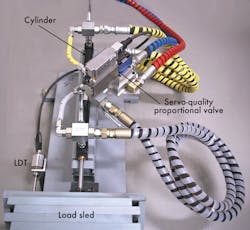Test Lab Gets It Wrong—On Purpose!
When you need to achieve precise motion and position control, electrohydraulic experts stress placing the servovalve or proportional valve as close to the cylinder as you can, and to use a manifold or steel tubing to connect the two. You should avoid using hydraulic hose in this situation because the hose’s flexibility is a source of positioning error as pressure increases and decreases.
Another shortcoming in hydraulic system design is using a cylinder with too small a bore. In doing so, system designers figure that increasing the operating pressure of the system will provide the cylinder with enough force to move and position the load.
Delta Computer Systems, Battle Ground, Wash., addresses these common issues and more in its newest lab. Trainees can experience the challenge of tuning an underdamped system and to learn how the advanced control algorithms in Delta’s RMC motion controllers can make it possible.
This test rig at Delta Computer Systems exhibits intentional flaws in hydraulic system design and demonstrates to users how Delta’s RMC Tools and Tuning Wizard features found in their RMC motion controllers can help overcome less-than-ideal control conditions.
Intentional Issues
The lab’s test rig features several elements that make it particularly instructive. The cylinder is deliberately undersized with a bore of only 1 in. for the designed load and acceleration. It also has a longer stroke—10 in.—than recommended for a cylinder with that small a bore. System operating pressure is 1,500 psi, and the rig’s load mass (420 lb) can be adjusted by adding or removing steel plates from its load sled. Position feedback is provided by an externally mounted magnetostrictive linear-displacement transducer. The LDT had to be mounted externally because the 1-in. cylinder did not afford a space large enough to accommodate internal mounting.
Motion is controlled by a high-response electrohydraulic proportional directional valve. The test rig also lets trainees install conduits between the servo-quality directional valve and cylinder ports using short sections of rigid pipe or tubing or long lengths of flexible hose. By shifting a few ball valves, trainees can switch between the 7 in. of hard-piped connections or 6 ft of hose connecting A and B valve ports to the head- and cap-end ports of the cylinder. As a result, the dramatic impact of increasing the volume of trapped oil is made obvious using Delta’s RMCTools Plot feature. Trainees can then use the RMC motion controller's Tuning Wizard to try to adjust the controller gains using first- and second-order tuning algorithms.
Thanks to Aaron Heinrich and Jacob Paso, of Delta Computer System for providing details on this setup.



